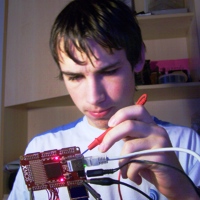Here's some tips on how I was able to hand solder the tiny USB3318. I ruined my first board attempting this, but changed methods on the second one and got it the first try. This may not be the best or only way, so make your own decisions. The problem with hand soldering either the USB3318 or the L1, is the power pad on the back. I did not want to invest in a stencil and use solder paste.
In order to do this, you must get a special PCB made with a thru hole in the middle of the pad. The L1 used a .110" hole. For the USB3318 a .80" thru hole. See the following example:
You also need to make a jig to hold the part down against the board securely when you solder from the back side. I glued to pieces of extra PCB material together then glued a stabilizer on the end. Attach to your board with rubber bands as shown (with the part underneath):
To solder:
1 - Apply some flux to the top side pads on the PCB.
2 - Tin (solder) the power pad of the part with as thin a coating as possible.
3 - Tin the top pad and the through hole with as thin a coating as possible.
4 - For the L1, positition the part then solder one pin on two sides to hold the part and use the jig if you want. For the USB3318 just use the jig. You really need a microscope to verify position.
5 - Flip the board over, without moving the jig or rubber bands. Place on something to keep the jig from touching anything.
6 - With a hotter than normal iron, solder through the hole on the back side to the power pad below. Do not apply any pressure to lift the part, but you need to touch the power pad to heat it. Let it heat for a bit, then apply some solder, when it reflows apply a little more. Do not use too much. You only need to solder the bottom of the hole against the part. If it doesn't reflow, you may need to repeat after solder wicking some solder off.
7 - Remove jig and verify placement under microscope. Gently push aginst the part to verify solder integrity.
8 - Solder the top side leads under a microscope, or magnifier. Do not apply any downward pressure, or you may lift a pad. Verify solder joints and no bridges.
9 - Good Luck!
How to hand solder XMOS L1 or USB3318
-
bearcat
- Respected Member
- Posts: 283
- Joined: Fri Mar 19, 2010 4:49 am
How to hand solder XMOS L1 or USB3318
You do not have the required permissions to view the files attached to this post.
-
TonyD

- XCore Addict
- Posts: 234
- Joined: Thu Dec 10, 2009 11:11 pm
- Location: Newcastle, UK
@bearcat
Thanks for sharing your great solder tips. I'll remember them for the next time I struggle trying to hand solder the L1.
Thanks for sharing your great solder tips. I'll remember them for the next time I struggle trying to hand solder the L1.
-
Berni

- Respected Member
- Posts: 363
- Joined: Thu Dec 10, 2009 10:17 pm
I used this method before, but i soldered down the chip first and done the thermal pad last. Also i did it on a homemade double sided PCB, not a professionally made one.
-
leon_heller

- XCore Expert
- Posts: 546
- Joined: Thu Dec 10, 2009 10:41 pm
- Location: St. Leonards-on-Sea, E. Sussex, UK.
I do it the same way as Berni, with QFN chips; drag-soldering the pads first after tacking down two opposite corners. Having a Metcal soldering station helps a lot with difficult soldering jobs like that. I've done it on home-made PCBs as well.
-
bearcat
- Respected Member
- Posts: 283
- Joined: Fri Mar 19, 2010 4:49 am
On the USB3318, I had first soldered the top side and saved the power pad for last. But that did not work. The part is so small, and the package more thermal conductive, it desoldered itself before I was able to solder the pad, and ruined the board. So I think it's better to go ahead and solder the pad first. That way you can also correct it if need be.
That USB3318 is a tiny QFN.
That USB3318 is a tiny QFN.
-
kster59
- XCore Addict
- Posts: 162
- Joined: Thu Dec 31, 2009 8:51 am
.5mm DFN is pretty easy to solder with a hot air gun.
Just squirt solder paste on the pads and hit it with the gun and the chip floats into place. It takes me less than 2 minutes.
Once the board is done, I squirt solder flux around the pads and use an iron to wick any possible shorts. Works 9 times out of 10 the first try.
.5mm qfp L1-64 is also easy.
.4mm qfp L1-128 is not so easy for me and it takes me several tries to remove shorts.
Just squirt solder paste on the pads and hit it with the gun and the chip floats into place. It takes me less than 2 minutes.
Once the board is done, I squirt solder flux around the pads and use an iron to wick any possible shorts. Works 9 times out of 10 the first try.
.5mm qfp L1-64 is also easy.
.4mm qfp L1-128 is not so easy for me and it takes me several tries to remove shorts.
-
sjalloq
- Active Member
- Posts: 55
- Joined: Tue Jan 12, 2010 1:49 pm
bearcat, a slightly off topic question, but what were your PCB design rules that you used for your L1 layout. I've been struggling to get a nice layout with 8/8/20mil (wire/spacing/drill) and am thinking of moving to a manufacturer who can support 6/6/15.
Cheers, Shareef.
Cheers, Shareef.
-
bearcat
- Respected Member
- Posts: 283
- Joined: Fri Mar 19, 2010 4:49 am
I used PhoenixGold. Their "standard" process is 7/7/15. The 15mil drill size is the most helpful. I used 10mil traces, or larger, in all exect a couple traces at 8mil on the L1. I believe the 10mil traces actually ended up narrower than that for some reason, but I have not measured them yet. The larger traces seemed about right. I had electrical test performed, and there were no failures. This order was received in a little over a week.
